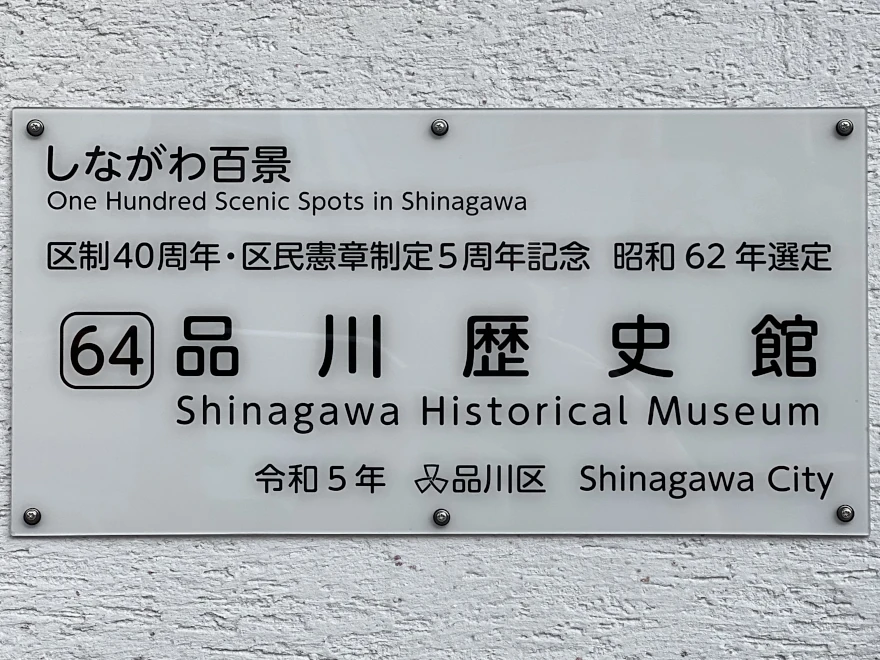🏛️ Shinagawa Historical Museum – Gateway to the Past
The Shinagawa Historical Museum (品川歴史館) is the central hub for exploring the layered history of Shinagawa Ward. Nestled in a quiet corner of Ōi, this museum reopened in 2024 after extensive renovations, offering a revitalized experience across both high-tech and traditional exhibition spaces. It presents not only an educational journey through prehistoric shell mounds, feudal estates, and modern urbanization, but also a tranquil garden sanctuary with a restored tea house and historic architecture.
🗺️ Four Eras of Shinagawa
The museum’s permanent exhibition room is divided into four chronological zones:
- Prehistoric & Ancient: Shinagawa as a marine settlement, linked by sea and land.
- Medieval: The area’s rise as a node in river and coastal transport.
- Early Modern (Edo): Gateway to Edo and a major Tōkaidō post town.
- Modern: Shinagawa’s industrial and international development in the 20th century.
💡 Interactive & Thematic Features
Just inside the entrance, visitors are welcomed by a Digital Timeline comparing Shinagawa’s history with major events in Japan and the world. On the second floor, the Shinagawa Navi corner presents curated information about the ward’s five districts—Shinagawa, Ōsaki, Ōi, Ebara, and Yashio—including sightseeing tips and historical trivia.
🔍 Morse Corner & Shell Mounds
One of the museum’s highlights is the Morse Corner, which honors Edward S. Morse, the American zoologist who discovered the Ōmori Shell Mounds in 1877. This exhibit explores his role in launching Japanese archaeology and includes artifacts and personal items.
📚 Free Access Areas
Outside the ticketed exhibits, several free-access spaces include:
- Library: Books and documents on Shinagawa history (non-lending).
- Live Lab: Historic tools and lifestyle objects on open display.
- Shinagawa Garden: A seasonal stroll garden featuring plum, cherry, and maple trees, as well as a recreated pit-dwelling and a working suikinkutsu (water harp cave).
🍵 Tea House & Shoin Study Hall
The Shoin and Matsuteki-an tea house are cultural assets of their own. The shoin building reuses original materials from a Showa-period mansion on the site, while the tea house was modeled after Rokusō-an and once hosted figures like Takahashi Korekiyo and Fujihara Ginjiro. These spaces are open to the public for traditional arts like flower arranging, haiku gatherings, and tea ceremonies (reservation required).
📍 Visitor Information
Address: 6-11-1 Ōi, Shinagawa City, Tokyo 140-0014
Opening Hours: 9:00 AM – 5:00 PM (Last admission 4:30 PM)
Closed: Mondays (or the next day if Monday is a holiday), New Year’s holidays
Admission: Adults ¥100, Children ¥50; Free for Shinagawa residents under 15 or over 65
Phone: 03-3777-4060
Official Website: Shinagawa Historical Museum
Note: The museum is wheelchair accessible. Group tours and school visits require advance booking.
Where is it?
| what3words | ///jacuzzi.slightly.cones |
| latitude longitude | 35.606547, 139.733003 |
| Nearest station(s) | Ōimachi Station (JR Keihin-Tōhoku, Tokyu, and Rinkai Lines) |
| Nearest public conveniences | In the museum complex |
Show me a sign.

The Hyakkei sign is posted right next to the main sign. Looks as good as new.
Withervee says…
Great for a rainy day or a quiet morning stroll through Tokyo’s lesser-known past. The shell mounds, Edo relics, and tea house garden offer a microcosm of Shinagawa’s layered history.
Compact, friendly, and sometimes bilingual — rare to find a museum this informative and welcoming.
Site Character
- Lifestyle 生活 (Seikatsu): ✔️
- Historical Significance 歴史 (Rekishi): ✔️
- Atmosphere/Natural Features 風土 (Fūdo): ✔️
Who in their right mind would vote for this?
- History buffs
- Japanese culture fans
- Quiet walkers
- Parents with kids
- Garden lovers
Further reading
While you’re there…
Visit the nearby Kashima Shrine or Ōmori Kaizuka Shell Mound or explore shopping and dining options around Ōimachi Station.
Previous
62: Oi Dontaku Summer Festival

